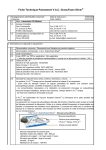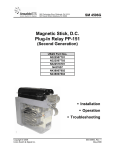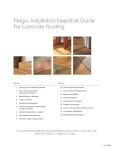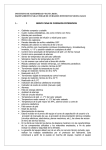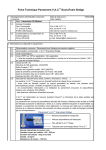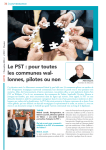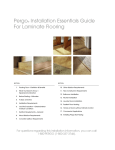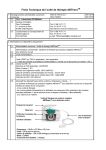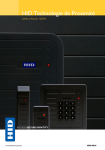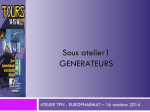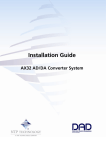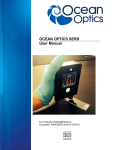Download V.A.C.® Therapy™ Clinical guidelines
Transcript
Edited by Paul Banwell, BSc(Hons), MB BS, FRCS(Eng), FRCS(Plast) V.A.C.® Therapy™ Clinical guidelines A reference source for clinicians Produced by MEP Ltd on behalf of KCI Ltd Medical Education Partnership Ltd 53 Hargrave Road, London N19 5SH www.mepltd.co.uk Copyright © KCI Ltd 2005 ISBN 90-78026-01-4 All rights reserved. No reproduction, copy or transmission of this publication may be made without written permission. No paragraph of this publication may be reproduced, copied or transmitted save with written permission or in accordance with the provisions of the Copyright, Designs & Patents Act 1988 or under the terms of any licence permitting limited copying issued by the Copyright Licensing Agency, 90 Tottenham Court Road, London W1P 0LP New, revised edition November 2005 V.A.C.® THERAPYTM RECOMMENDED GUIDELINES Indication Therapy setting Foam type Non-adherent interposed dressing Special considerations* Acute/traumatic wounds Continuous for first 48 hours; intermittent for rest of therapy Usually GranuFoam®, unless otherwise indicated Caution should be used when placing V.A.C.® dressings over exposed tendons and nerves. These structures must not be allowed to dry out. V.A.C.® Therapy™ should not be used over exposed organs and/or blood vessels Specialist management required. Foam dressings should not be placed over exposed organs and/or blood vessels Abdominal wounds Continuous for duration of therapy GranuFoam® recommended for superficial wounds. Indicationspecific dressings are available for deep wounds In wounds with exposed bowel, an indication-specific dressing is recommended or a fine-mesh, non-adherent interposed dressing to cover exposed bowel Specialist management required. Effective management of abdominal wounds depends on the wound being classified as either superficial, deep or complex Sternal wounds Continuous for duration of therapy Usually GranuFoam®, unless otherwise indicated Use a fine-mesh, non-adherent interposed dressing over exposed heart or other exposed organs Specialist management required. Foam dressings should not be placed over exposed organs and/or blood vessels Pressure ulcers (full-thickness) Continuous for first 48 hours; intermittent for rest of therapy Usually GranuFoam®, unless otherwise indicated. Indicationspecific dressings are available Not usually required Always address underlying aetiology and factors affecting healing. Special dressing technique can be used to protect skin from frequent dressing changes Lower extremity ulcers Continuous for first 48 hours; intermittent for rest of therapy Usually GranuFoam®, unless otherwise indicated Not usually required Always address underlying aetiology and factors affecting healing. Special dressing technique can be used to protect skin from frequent dressing changes Diabetic foot ulcers Continuous for first 48 hours; intermittent for rest of therapy Usually GranuFoam®, unless otherwise indicated. Indication-specific dressings are available Not usually required Always address underlying aetiology and factors affecting healing. Special dressing technique can be used Infected wounds Continuous for duration of infection Usually GranuFoam®, unless otherwise indicated Cover exposed organs and/or blood vessels with one or more layers of a fine-mesh, nonadherent interposed dressing depending on wound type Dressings must be changed every 12-24 hours until infection has resolved. Depending on microbiological status, consider antibiotic therapy Other postoperative wounds Intermittent once exudate levels have stabilised Usually GranuFoam®, unless otherwise indicated Cover exposed organs and/or blood vessels with one or more layers of a fine-mesh, non-adherent interposed dressing Do not place foam dressing over exposed organs and/or blood vessels Grafts and dermal substitutes Continuous for duration of therapy. 75-125mmHg for GranuFoam®, 125mmHg for Vers-Foam™ Usually GranuFoam®, unless otherwise indicated Single wide-mesh, non-adherent interposed Remove dressing after 4-5 days. Assess the dressing with GranuFoam® only. A non-adherent wound if there is any sign of infection interposed dressing is not required with Vers-Foam™ Flaps Continuous for duration of therapy Usually GranuFoam®, unless otherwise indicated. Vers-Foam™ wick may be required Single wide-mesh, non-adherent interposed dressing over exposed suture line if GranuFoam® is used (not required with Vers-FoamTM) Enteric fistulae Dressing change 72 hours postoperatively, every 48 hours with complications and every 12-24 hours with infection Specialised management required. Seek advice/support from local KCI personnel Unless otherwise indicated (e.g. see Flaps), dressings should be changed every 48 hours, or every 12-24 hours in the presence of infection * Refer to Wound-specific advice and protocols (p23-32) for further information on special considerations. © KCI Ltd 2005 CONTENTS These guidelines are not intended as a guarantee of results, outcome or performance of the V.A.C.® System. They are recommendations to help clinicians to establish patientspecific treatment protocols. As with any application, please consult the patient’s lead clinician about individual conditions and treatment, and follow all applicable manuals and reference guides as to product use and operation. Always consult sections of this booklet and any other product labelling and instructions before placing a V.A.C.® product on a patient. Contact your local KCI representative if you have any questions about operation or use. For further information visit www.kci-medical.com 1 Introduction 2 Tips for using V.A.C.® Therapy™ Indications, contraindications and precautions The V.A.C.® family of devices 2 3 4 1. V.A.C.® Therapy™ unit and accessories 5 V.A.C.® System pressure settings V.A.C.® accessories Optimising therapy 5 7 8 2. Dressing application guidelines 9 Dressing application technique Tips for dressing application Connecting the V.A.C.® Therapy™ unit and commencing therapy Dressing removal Changing the canister and Y-connector Disconnecting from the V.A.C.® Therapy™ unit 9 11 12 13 14 14 3. Specific dressing techniques 15 Treating multiple wounds The tunnelling technique Wound undermining Dressing foot wounds Indication-specific dressings Wound edge reapproximation and dressing technique Dressings and faecal incontinence Dressing small wounds and T.R.A.C.® Pad application 15 16 17 17 18 19 20 20 4. Wound monitoring 21 Healing progress Wound deterioration 21 21 5. Wound-specific advice and protocols 23 Acute/traumatic wounds Abdominal wounds Sternal wounds Pressure ulcers Lower extremity ulcers Diabetic foot ulcers Infected wounds Other postoperative wounds Meshed grafts and dermal substitutes Flaps Enteric fistulae Tips for practical fistulae management V.A.C.® Therapy™ and hyperbaric oxygen therapy V.A.C.® Therapy™ and magnetic resonance imaging (MRI) 23 24 25 26 27 27 28 28 29 30 31 31 32 32 6. Care and safety tips 33 V.A.C.® Therapy™ unit considerations Wound care considerations Anatomical considerations Other considerations 33 34 35 36 Index 37 2 INTRODUCTION Vacuum assisted closure (V.A.C.®) is an advanced wound healing therapy that can be readily integrated into the clinician’s wound healing armamentarium, optimising patient care and reducing costs. It is a flexible therapy in that it may be used both in hospital and community settings. State of the art wound healing technology coupled with microprocessor-controlled therapy units and first-class technical back-up provide peace of mind for both clinicians and patients. The V.A.C.® family of devices (see p4) is used to help promote wound healing through a multimodality action under the influence of continuous and/or intermittent negative pressure in association with wound-site feedback control (T.R.A.C.® technology). According to FDA clearance, applying negative pressure to the wound helps to promote wound healing and achieve the following: remove infectious materials and/or other fluids, assist tissue granulation in wounds, draw the edges of the wound together, decrease wound size, help promote perfusion to the wound and promote a moist wound healing environment. V.A.C.® Therapy™ has been defined as a novel, powerful, non-pharmacological physical wound healing modality capable of modulating the wound healing process (Banwell PE, Téot L. Topical negative pressure (TNP): the evolution of a novel wound therapy. J Wound Care 2003; 12(1): 22-28). TIPS FOR USING V.A.C.® THERAPY™ ■ Ensure that the patient/wound is a suitable candidate for V.A.C.® Therapy™. ■ If no response/improvement in the wound is observed within two weeks, reconsider treatment. ■ Ensure accurate diagnosis and that all underlying and associated causes have been addressed. ■ Ensure appropriate debridement prior to treatment. ■ Ensure a good seal has been achieved. ■ Ensure accurate foam selection and indication-specific dressings are used as appropriate. ■ Do not pack the foam; place gently in the wound and accurately record the number of foam pieces used in the patient’s notes and, if possible, on the drape. ■ Do not place directly over exposed organs and/or blood vessels. ■ Keep therapy on for 22 out of 24 hours. Do not leave the V.A.C.® dressing in situ if the therapy unit is switched off for more than two hours. ■ Monitor continuously, and check and respect alarms. ■ Seek advice/support from local KCI personnel. Universal precautions Use gloves, a gown and goggles if splashing or exposure to body fluids is a possibility. Treat all body fluids as if they are contaminated. All steps should be taken under the direction of the lead clinician and in accordance with local protocols. INTRODUCTION INDICATIONS According to FDA clearance V.A.C.® Therapy™ is indicated for patients with chronic, acute, traumatic, subacute and dehisced wounds, partial-thickness burns, ulcers (such as diabetic or pressure), flaps and grafts. CONTRAINDICATIONS V.A.C.® Therapy™ is contraindicated where there is: ■ necrotic tissue/eschar ■ direct placement of V.A.C.® dressings over exposed blood vessels and/or organs ■ untreated osteomyelitis ■ non-enteric or unexplored fistulae ■ malignancy in the wound. PRECAUTIONS Precautions should be taken for patients: ■ with active bleeding ■ with difficult wound haemostasis ■ who are taking anticoagulant medication. Precautions should be taken: ■ when placing the V.A.C.® dressing in close proximity to blood vessels, organs or exposed tendons. Ensure these are adequately protected with overlying fascia, tissue or other protective barriers ■ with respect to weakened, irradiated or sutured blood vessels or organs ■ in the presence of bone fragments or sharp edges. These could puncture protective barriers, vessels or organs ■ with enteric fistulae, which require special precautions to optimise V.A.C.® Therapy™. Refer to p31 of this guide. Notice to users: As with any medical device, failure to follow product instructions or adjusting settings and performing therapy applications without the express direction and/or supervision of a trained clinician may lead to improper product performance and the potential for serious or fatal injury. 3 4 INTRODUCTION 1. V.A.C.® THERAPY™ UNIT AND ACCESSORIES THE V.A.C.® FAMILY OF DEVICES These V.A.C.® Therapy™ clinical guidelines are for use with the V.A.C.® Classic, V.A.C. ATS®, V.A.C. Freedom® and Mini V.A.C.® therapy systems. Not all have the same features or require the same guidelines. Please also refer to the specific instructions for use based on the CE product approval. V.A.C.® SYSTEM PRESSURE SETTINGS The guidelines on therapy settings in this booklet are general recommendations. You may wish to vary the pressure settings to optimise V.A.C.® Therapy™ based on individual patient need and the lead clinician’s guidance. All components of the V.A.C.® System are FDA cleared, CE marked, latex-free and packaged sterile to optimise patient outcomes. V.A.C. ATS® System V.A.C. Freedom® System Adjusting the pressure settings For recommended pressure settings for specific wound types, refer to Wound-specific advice and protocols (p23). The V.A.C.® pressure setting may be titrated up by 25mmHg increments where there is: ■ excessive drainage ■ large wound volume ■ V.A.C.® Vers-Foam™ dressing(s) in the wound or in tunnelled areas ■ a tenuous seal (see Maintaining a seal, p11). The V.A.C.® pressure setting may be titrated down by 25mmHg increments where: ■ pain or discomfort is unrelieved by appropriate analgesia ■ the patient is elderly and/or nutritionally compromised ■ there is a risk of excessive bleeding (for example, patients on anticoagulation therapy) ■ the circulation is compromised (for example, peripheral vascular disease) ■ there is excessive granulation tissue growth. For use with T.R.A.C.® disposables For use with T.R.A.C.® disposables V.A.C.® Classic System Mini V.A.C.® System The default setting for V.A.C.® Therapy™ is 125mmHg on a continuous setting. Continuous versus intermittent therapy V.A.C.® Therapy™ research in porcine models has shown that intermittent therapy (five minutes suction on, two minutes suction off) can stimulate faster granulation tissue formation than continuous negative pressure alone. However, the application of continuous negative pressure stimulates granulation tissue formation significantly faster than the application of simple, non-adherent dressings (Morykwas MJ, Argenta LC, Shelton-Brown EI, McGuirt W. Vacuum-assisted closure: a new method for wound control and treatment: animal studies and basic foundation. Ann Plast Surg 1997; 38(6): 553-62). For use with V.A.C.® disposables For use with Mini V.A.C.® disposables Certain unique indications, contraindications, precautions and safety tips may apply to individual products within the V.A.C.® family of devices. Please refer to the instructions for each specific product. This research has helped to establish the guidelines for the recommended mode of therapy (continuous or intermittent) and the amount of negative pressure that should be applied to various wounds. Continuous therapy is recommended for the first 48 hours in all wounds. Although intermittent therapy is usually the preferred option following this, patients may be better served on continuous therapy for the duration of treatment in the circumstances described overleaf. 5 6 1. V.A.C.® THERAPY™ UNIT AND ACCESSORIES 1. V.A.C.® THERAPY™ UNIT AND ACCESSORIES Indications for continuous therapy Continuous therapy after the first 48 hours is indicated where: ■ patients experience significant discomfort during intermittent therapy ■ it is difficult to maintain an airtight seal (for example, perianal or toe wounds) ■ there are tunnels or undermined areas as continuous therapy helps to hold the wound closed, collapsing the edges and encouraging granulation (see The tunnelling technique, p16) ■ there are high levels of drainage from the wound after the first 48 hours (it is better to wait until the amount of drainage tapers off before switching to intermittent mode) ■ there are grafts or flaps to prevent shear ■ a splinting effect is required (e.g. sternal or abdominal wounds). Intensity feature Intensity is the rate at which target pressure is reached after the initiation of therapy. The lower the intensity setting the slower the target pressure will be reached. It is recommended that patients new to therapy begin at the lowest intensity setting as this allows for a slower, gentler increase of negative pressure and resultant compression of the foam in the wound. The intensity can remain at the minimum setting throughout treatment to enhance patient comfort, especially when using intermittent therapy. Higher intensity settings may be required for larger wounds. V.A.C.® ACCESSORIES A number of V.A.C.® accessories are available for use with specific V.A.C.® systems. These include canisters, tubing, drape, gel pads, foam dressings and the T.R.A.C.® Pad. In addition, indication-specific V.A.C.® dressings are also available. Refer to p18 or visit the website at www.kci-medical.com for further details. V.A.C. Drape® V.A.C.® canisters T.R.A.C.® Pad Specialist foam dressings KCI provides two types of foam for use with the V.A.C.® System. They are: V.A.C.® GranuFoam® This black, polyurethane (PU) foam dressing has reticulated open pores and is considered to be the most effective at stimulating granulation tissue while aiding wound contraction. It is hydrophobic (or moisture repelling), which enhances exudate removal. The intensity feature is not available with all V.A.C.® systems so please refer to the appropriate user’s manual or on-screen user’s guide. V.A.C.® GranuFoam® Table 1.1: Additional recommended therapy settings Wound characteristics Continuous Continuous or intermittent Intensity setting Difficult dressing application ■ Higher Flaps ■ Lower Highly exuding ■ Higher Grafts ■ Lower Painful wounds ■ Lower Tunnels or undermining ■ Higher Unstable structures ■ Either Minimally exuding ■ Lower Large wounds ■ Higher Small wounds ■ Lower Stalled progress ■ Either V.A.C.® Vers-Foam™ ■ Higher V.A.C.® Vers-Foam™ V.A.C.® Vers-Foam™ This white, polyvinyl alcohol (PVA) foam dressing is a dense, open pore foam with a high tensile strength. It is hydrophilic (or moisture retaining) and is premoistened with sterile water. It possesses overall nonadherent properties and does not usually require the use of an additional dressing to prevent it from adhering to the wound. It is generally recommended for use in wounds where the growth of granulation tissue into the foam needs to be controlled or when the patient cannot tolerate V.A.C.® GranuFoam® because of discomfort. The higher density of V.A.C.® Vers-Foam™ requires higher pressures to provide adequate negative pressure therapy distribution throughout the wound. A minimum pressure setting of 125mmHg is recommended when using V.A.C.® Vers-Foam™. 7 8 2. DRESSING APPLICATION GUIDELINES 1. V.A.C.® THERAPY™ UNIT AND ACCESSORIES Table 1.2: Selecting an appropriate foam dressing Wound characteristics V.A.C.® GranuFoam® (black) Deep, acute wounds with moderate granulation tissue present ■ Full-thickness pressure ulcers (Grade 3 or 4) ■ Flaps ■ V.A.C.® Vers-Foam™ (white) Extremely painful wounds ■ Superficial wounds ■ Tunnelling/sinus tracts/undermining ■ Wounds that require controlled growth of granulation tissue ■ Either DRESSING APPLICATION TECHNIQUE The V.A.C.® dressing should be changed once every 48 hours, or every 12-24 hours in the presence of infection. Universal precautions should be observed. The following recommendations offer step-by-step guidelines for dressing application: 1. Prepare the wound for dressing application ■ If V.A.C.® Therapy™ is already in place, see Dressing removal (p13). ■ Appropriate debridement of eschar or hardened slough if present (see Optimising therapy, p8). ■ Achieve haemostasis. ■ Thoroughly clean and irrigate wound according to local protocol using normal saline or solution as directed by the lead clinician. Deep trauma wounds ■ Diabetic foot ulcers ■ 2. Prepare the periwound area Dry wounds ■ ■ Clean and dry the periwound tissue: if skin is moist as a result of perspiration, oil or Post-graft placement (including dermal substitutes) ■ Lower extremity ulcers ■ Note: these are general recommendations. The lead clinician’s guidance should always be sought as individual circumstances may vary. OPTIMISING THERAPY Maximum benefit from negative pressure therapy depends on both effective holistic wound healing strategies and good wound care. For example, the patient must: ■ receive an accurate diagnosis and appropriate treatment of underlying causes, for example the provision of adequate nutrition and pressure relief in the case of pressure ulcers ■ be concordant with treatment. Maintain active negative pressure therapy for 22 out of 24 hours a day. If therapy is turned off for more than two hours a day, the dressing must be removed and replaced with a traditional dressing. Patients with a history of non-concordance with other therapies should be monitored closely throughout V.A.C.® Therapy™ ■ receive clinical evaluation and guidance on a regular basis. Overall outcomes may be improved when a KCI representative is involved in supporting clinicians using V.A.C.® Therapy™ ■ be actively receiving treatment for osteomyelitis, including appropriate debridement (bone if necessary) and antibiotic therapy. To obtain maximum benefit from negative pressure therapy, the wound must: ■ be debrided of all eschar and hardened slough. Devitalised tissue should be removed as thoroughly as possible according to the instructions of the lead clinician ■ be supplied by adequate circulation to support the healing process. body fluids, a degreasing agent may be required. ■ You may apply a skin preparation such as a liquid surgical adhesive or liquid barrier film to the periwound tissue. ■ For patients with fragile or excoriated periwound tissue, a protective, thin-layered dressing such as V.A.C. Drape®, a hydrocolloid dressing or a vapour-permeable adhesive film dressing may be applied to the periwound area. 3. V.A.C.® foam application ■ Note the wound type and condition, and select an appropriate foam (see Table 1.2). ■ Note the wound dimensions and cut the foam to dimensions that will allow it to be placed gently into the wound. Use large scissors or a scalpel to cut the foam and gently rub the freshly cut edges to remove any loose pieces of foam. Do not cut or rub the foam over the wound. ■ Gently place the foam in the wound cavity, covering the entire wound base and sides, tunnels and undermined areas. ■ If the wound is larger than the largest dressing, more than one piece of foam may be required. If you use more than one make sure that all adjoining edges of foam are in direct contact with each other to ensure an even distribution of negative pressure. ■ Count the pieces of foam and record the total in the patient’s notes – this may also be annotated on the drape with a permanent marker. Do not pack the foam into the wound (always place gently) as this may inhibit reduction of the wound size. Do not cut or rub the foam over the wound. Do not cut the foam larger than the wound as this may lead to excoriation and damage to the periwound skin. 9 10 2. DRESSING APPLICATION GUIDELINES V.A.C. Drape® ® V.A.C. foam V.A.C. Drape® application 2. DRESSING APPLICATION GUIDELINES 4. Preparing the V.A.C. Drape® ■ Size and trim the drape to cover the foam dressing as well as an additional 3-5cm border. ■ Apply drape over the entire wound, including the foam dressing and about 3-5cm of surrounding intact skin. Cutting the drape into smaller pieces may aid application. ■ If the skin surrounding the wound site is excessively moist or oily, a medical grade liquid adhesive may improve adhesion. V.A.C.® tubing V.A.C. Drape® V.A.C.® foam V.A.C.® Classic application: ■ Cut a 1-2cm hole through the drape as directed in T.R.A.C.® Pad application (p10) and into the foam. Make sure it is large enough to allow you to insert the tubing into the foam. Ensure that the tubing does not come into contact with the wound bed. ■ Insert the tubing into the hole and secure with additional drape. V.A.C.® Classic system Do not stretch the drape and place onto skin under tension. Do not discard excess drape as you may need it later in the application to patch difficult areas. For both T.R.A.C.® Pad and V.A.C.® Classic applications pay particular attention to the position of the tubing, avoiding placement over bony prominences or in creases in the tissue. 5. Applying the tubing The V.A.C. ATS® and V.A.C. Freedom® systems use a T.R.A.C.® Pad (with integrated tubing). TIPS FOR DRESSING APPLICATION T.R.A.C.® Pad application: ■ Lift the drape with your thumb and forefinger and cut a 1-2cm round hole in it that is large enough to allow fluid to pass through the dressing. It is not necessary to cut into the foam. ■ Apply the T.R.A.C.® Pad opening directly over the hole in the drape. ■ Apply gentle pressure around the T.R.A.C.® Pad to ensure complete adhesion. ■ For wounds that are smaller in dimension (<4cm) than the T.R.A.C.® Pad, a special dressing application is required to carefully protect the periwound tissue. See Dressing small wounds and T.R.A.C.® Pad application, p20. T.R.A.C.® Pad T.R.A.C.® Pad application Do not cut off the T.R.A.C.® Pad and insert the T.R.A.C.® tubing into the foam. This will cause the therapy unit alarm to sound. Do not cut a linear slit in the drape because when negative pressure is applied a slit may collapse and close, preventing negative pressure from reaching the wound. Preventing adherence To prevent the dressing from adhering to the wound bed, you may consider the following: ■ applying a single layer of wide-meshed non-adherent interposed dressing between the foam dressing and the wound. The non-adherent material must have pores that are wide enough to allow the unrestricted passage of air and fluid ■ using V.A.C.® Vers-Foam™ because tissue growth into V.A.C.® GranuFoam® may cause adherence ■ more frequent dressing changes. All adjunct dressings must be used according to local protocols and manufacturers’ instructions. Maintaining a seal Maintaining a seal around the dressing is the key to successful V.A.C.® Therapy™. The following are among the best ways to maintain the integrity of the seal: ■ dry the periwound area thoroughly after cleansing. You may use a skin preparation or degreasing agent to prepare the skin for the drape application (for example, a liquid surgical adhesive or liquid barrier film) ■ for delicate periwound tissue or in areas that are difficult to dress, frame the wound with a skin barrier to enhance the seal ■ ensure the V.A.C.® GranuFoam® dressing is appropriate for the depth of the wound by either cutting or bevelling it or use specific thinner V.A.C.® GranuFoam® dressings where indicated ■ try to position the dressing tubing on flat surfaces and away from the perineal area, bony prominences or pressure areas 11 12 2. DRESSING APPLICATION GUIDELINES ■ secure or anchor the tubing with an additional piece of drape or tape several centimetres away from the dressing/wound. This prevents it from pulling on the wound area, which can cause leaks ■ a circumferential drape technique may sometimes be necessary to establish and maintain a seal. Extreme care should be taken not to stretch or pull the drape when securing it, but let it attach loosely and stabilise the edges with a self-adhesive elastic wrap ■ for the V.A.C.® Classic only, another option is to seal the drape over the foam with the tubing removed. Then make a slit in the top of the dressing through the occlusive drape and 0.5-1cm into the foam. Lay the tubing inside the shallow slit in the foam so that the foam surrounds the holes in the tubing. Cut strips of drape and use them to patch over the drape hole and tubing using a mesentery technique. Care must be taken when placing circumferential drapes on patients with neuropathic aetiologies or those with a history of numbness and/or tingling. CONNECTING THE V.A.C.® THERAPY™ UNIT AND COMMENCING THERAPY Remove the canister from the sterile packaging and push it into the V.A.C.® Therapy™ unit until it clicks into place. If the canister is not engaged properly the V.A.C.® Therapy™ unit alarm will sound. Proceed according to the following recommendations: 1. Connect the dressing tubing to the canister tubing. Make sure both clamps are open. 2. Place the V.A.C.® Therapy™ unit on a level surface or hang from the foot board or intravenous therapy pole. The V.A.C.® Classic unit’s alarm will sound and therapy will be discontinued if the unit is tilted beyond 45 degrees. 3. Press the power button to turn on the V.A.C.® Therapy™ unit. 4. Adjust the V.A.C.® Therapy™ unit settings in accordance with the Wound-specific advice and protocols (p23). 5. Press THERAPY ON/OFF button to activate negative pressure therapy. In less than one minute the V.A.C.® dressing should collapse, unless leaks are present. 6. If you hear or suspect a leak (small leaks may create a whistling noise), you can often fix it by gently pressing around the tubing and wrinkles to seal the drape. You can also use excess drape to patch over leaks. After initiating therapy, it is crucial to palpate distal pulses to ensure circulatory patency and to question the patient about the presence of numbness and/or tingling sensations. If these are present, stop therapy and loosen the drape. Instruct the patient to discontinue therapy and contact their clinician if numbness, tingling or increased pain occur during therapy. 2. DRESSING APPLICATION GUIDELINES Ensuring dressing integrity It is recommended that a clinician or patient (in the home) visually check the dressing every two hours to ensure that the foam is firm and collapsed in the wound bed while therapy is active. If not, follow the advice below: ■ make sure the display screen reads THERAPY ON. If not, press the THERAPY ON/OFF button ■ make sure the clamps are open and the tubing is not kinked ■ identify air leaks by listening with a stethoscope or moving your hand around the edges of the dressing while applying light pressure ■ if you find that the seal is broken and the transparent dressing (e.g. drape) has come loose, patch with strips of adhesive drape as needed. DRESSING REMOVAL Gently remove an existing V.A.C.® dressing according to the following procedure: 1. Consider the strategies outlined under Pain management (see p36). 2. Raise the tubing connectors above the level of the therapy unit. 3. Close clamp on the dressing tubing. 4. Separate canister tubing and dressing tubing by disconnecting the connector. 5. Allow the therapy unit to pull the exudate in the canister tube into the canister then close the clamp on the canister tubing. 6. Press THERAPY ON/OFF to deactivate the V.A.C.® Therapy™ unit. 7. Wait for 15-30 minutes to allow for foam to decompress. Gently stretch the drape horizontally and slowly pull up from the skin. Do not peel. Gently remove foam from the wound. Consider simultaneous saline irrigation. 8. Discard disposables in accordance with local protocol. Managing dressing adherence If previous dressings were difficult to remove, consider introducing normal saline into the dressing. 1. Turn therapy OFF and clamp canister tubing. 2. Ensure dressing tube clamp is open. 3. Introduce 10-30ml of normal saline into the drainage tubing. For best results, leave in situ for 15-30 minutes to soak underneath the foam. 4. Gently remove the dressing. If significant discomfort is experienced during dressing changes you may, on the advice of the lead clinician, consider introducing 1% lidocaine solution down the tubing. Instil the lidocaine solution as recommended above and wait 15-30 minutes before gently removing the dressing. If the dressing adheres to the wound base, consider the techniques outlined under Preventing adherence (see p11). 13 14 2. DRESSING APPLICATION GUIDELINES 3. SPECIFIC DRESSING TECHNIQUES CHANGING THE CANISTER AND Y-CONNECTOR The V.A.C.® canister should be changed as follows when full (the alarm will sound), on average once every 3-5 days, or at least once a week to control odour: 1. The system may contain body fluids so follow Universal precautions. 2. Close the clamps on both the canister and dressing tubing. 3. Disconnect the canister tubing from the dressing tubing. 4. Remove the canister from the unit. 5. Dispose of the canister according to local protocol. TREATING MULTIPLE WOUNDS By applying a Y-connector to the canister tubing, one V.A.C.® Therapy™ unit may be used to treat multiple wounds on the same patient simultaneously. V.A.C.® Classic Y-connector V.A.C.® Classic tubing and Y-connector application T.R.A.C.® Pad Y-connector 15 T.R.A.C.® Pad tubing and Yconnector application The Y-connector should also be changed at least once a week or more frequently as needed: ■ If it is due to be changed disconnect the Y-connector with the canister tubing and dispose of according to local protocol. ■ If the Y-connector is not yet due to be changed, disconnect the canister tubing from the Y-connector and leave the Y-connector connected to the dressing tubing. The bridging technique Wounds that are in close proximity to one another on the same patient and of similar pathologies may also be treated with one V.A.C.® Therapy™ unit using a technique known as bridging. The advantage of bridging is that it requires only one piece of tubing, which is more convenient for the patient and decreases the likelihood of leaks. DISCONNECTING FROM THE V.A.C.® THERAPY™ UNIT Patients should be disconnected from the unit only for short periods of time and for no more than a total of two hours a day. To disconnect for short periods of time: 1. Close the clamps on the canister and tubing. 2. Turn the therapy unit OFF. 3. Disconnect the dressing tubing from the canister tubing. 4. Cover the ends of the tubing with gauze and secure or, if available, use a tubing cap. To re-connect: 1. Remove the gauze or tubing cap from the end of the tubing. 2. Reconnect the dressing tubing and the canister tubing. 3. Open both clamps. 4. Turn the therapy unit ON. Previous therapy settings will resume. Bridging technique The following recommendations offer step-by-step guidelines for bridging: 1. Protect intact skin between the two wounds with a piece of V.A.C. Drape® or other skin barrier such as a hydrocolloid dressing or a vapour-permeable adhesive film dressing. 2. Place foam dressing in both wounds, then connect the two wounds with an additional piece of foam, forming a bridge. All foam pieces must be in direct contact with each other. 3. It is important to place the tubing or T.R.A.C.® Pad in a central location to ensure that exudate from one wound is not drawn across the other wound. 16 3. SPECIFIC DRESSING TECHNIQUES 3. SPECIFIC DRESSING TECHNIQUES THE TUNNELLING TECHNIQUE Always cut the V.A.C.® Vers-Foam™ wider at one end and narrow at the other. This will ensure that the opening to the tunnel remains patent until the distal portion of the tunnel has closed. Therapy pressure settings should be increased by 25mmHg in the presence of a tunnel and continuous therapy should always be used until the tunnel has completely closed. Do not place foam into blind or unexplored tunnels. Initial dressing application 1. Determine the length and width of the tunnel using a measuring device of your choice. 2. Cut the foam to a size that accommodates the tunnel’s dimensions, plus 1-2cm into the wound bed. Gently place the foam into the tunnel all the way to the distal portion. The foam in the tunnel should communicate with the foam in the wound bed. Subsequent dressing changes As the drainage begins to diminish and the presence of granulation tissue is noted subsequent dressing changes must be altered in the following way: 1. Determine the length and width of the tunnel as above. 2. Cut the V.A.C.® Vers-Foam™ wider at one end and narrow at the other. 3. Gently place the foam into the tunnel all the way to the distal portion. 4. Pull out 1-2cm and ensure that some tunnel foam communicates with the foam in the wound bed. This specific placement leaves the distal portion of the tunnel clear of foam and enables the distribution of higher pressures to collapse the edges together, allowing the wound to granulate together from the distal portion forward. 5. Initiate continuous therapy at previous settings. 6. Repeat this procedure until the tunnel has closed. WOUND UNDERMINING Always use continuous therapy in the presence of wound undermining. Initial dressing application 1. Gently place V.A.C.® Vers-Foam™ in all undermined areas, beginning at the distal portion. 2. Monitor the amount of exudate and presence of granulation tissue at each dressing change. Subsequent dressing changes When the exudate volume decreases and the presence of granulation tissue is noted subsequent dressing changes must be altered in the following way: 1. Gently place the foam into the undermined areas all the way to the distal portion. 2. Pull out 1-2cm, leaving some foam in the wound to communicate with the foam in the wound bed. This specific placement leaves the distal portion of the undermined area clear of foam, allowing the distribution of higher pressures to collapse the free areas of undermining together, encouraging the wound cavity edges to granulate together from the distal portion forward. 3. Initiate continuous therapy at previous settings. V.A.C.® Vers-FoamTM Pull the V.A.C.® Vers-Foam™ out 1-2cm, leaving the distal portion of the tunnel clear of foam Be sure to mark on the dressing and record in the patient’s notes the exact number of pieces of foam that have been placed into all aspects of the wound, as well as the placement of any adjunct dressings such as non-adherent or silverimpregnated dressings. DRESSING FOOT WOUNDS For wounds on the plantar surface or heel of the foot, it is best to use a bridging technique to ensure that no additional pressure is applied as a consequence of the placement of the tubing. This involves using foam to allow placement of the T.R.A.C.® Pad or tubing to the dorsum of the foot. Follow these recommendations: ‘C’ cut for wounds on the 1. Gently place a foam dressing into the wound. plantar surface ® 2. Apply the V.A.C. Drape or another occlusive barrier from the wound edge to the anterior aspect of the foot. 3. Cut another piece of foam in the shape of a letter ‘C’. 4. Place the C-shaped piece of foam around the foot, extending from the wound to the lateral aspect, and ensure that it is in contact with the foam dressing in the wound. 5. Apply the V.A.C. Drape® or another occlusive barrier over the dressing and extend it round to the anterior aspect of the foot, covering both the wound and the C-shaped piece of foam to obtain a seal. 6. Cut a hole in the drape on the anterior aspect of the foot and either insert the tubing and seal it with drape or apply a T.R.A.C.® Pad. A specialised heel dressing is now available (see Indication-specific dressings, p18). 17 18 3. SPECIFIC DRESSING TECHNIQUES 3. SPECIFIC DRESSING TECHNIQUES INDICATION-SPECIFIC DRESSINGS A range of dressings has been specially designed for use on specific wound types that are difficult to dress. It includes the following: V.A.C.® GranuFoam® hand dressing V.A.C.® GranuFoam® abdominal dressing system V.A.C.® GranuFoam® thin dressing for more shallow wounds V.A.C.® GranuFoam® heel dressing V.A.C.® GranuFoam® round dressing for pressure ulcers V.A.C.® GranuFoam® extra large dressing for large wounds WOUND EDGE REAPPROXIMATION AND DRESSING TECHNIQUE In open wounds without significant tissue loss, such as open abdominal wounds, infected Caesarean section wounds and fasciotomy wounds, V.A.C.® Therapy™ may be used to encourage reapproximation of the wound edges. Topical negative pressure applied to the wound uses the visco-elastic properties of the skin adjacent to the wound to aid closure by stretching it forward and advancing the wound edges. An analogy has been made to the technique of tissue expansion used by plastic surgeons, and the effect has been described as ‘reverse tissue expansion’ (Banwell PE, Musgrave M. Topical negative pressure therapy: mechanisms and indications. International Wound Journal 2004; 1(2): 95). Initial dressing application should include gently placing the V.A.C.® GranuFoam® dressing into the wound and using higher pressure settings (minimum 150mmHg) to encourage the removal of excessive debris. Initial foam application, after which progressively smaller pieces of foam are used Sutures or staples may be used to secure the dressing For subsequent dressing applications the foam should be cut progressively smaller to allow controlled reapproximation of the wound edges. Controlled reapproximation of the wound edges allows for gradual closure Complete closure is achieved 19 20 3. SPECIFIC DRESSING TECHNIQUES 4. WOUND MONITORING DRESSINGS AND FAECAL INCONTINENCE Faecal incontinence is not a contraindication for V.A.C.® Therapy™. Many incontinent patients with sacrococcygeal or perineal wounds can benefit from V.A.C.® Therapy™. There are a number of ways to combat or control potential leakage of faeces into the wound dressing. HEALING PROGRESS The wound appearance should begin to change colour and become a deeper red as perfusion increases. Wound dimensions should begin to decrease as the active state of healing progresses. Weekly wound measurements should be taken and documented according to local protocol for subsequent comparison and to effectively assess the progression of healing. As the wound continues to form granulation tissue, new epithelial growth should be seen at the wound edges. Please review the suggestions below: ■ use a rectal collection system (such as a faecal bag or rectal catheter) ■ frame the wound with V.A.C. Drape®, a flexible skin barrier or other skin preparation that will help prevent the dressing from coming off due to contact with faeces. The barrier layer helps to create a dam between the anus and the area likely to come into contact with faeces ■ in extreme circumstances, consider the suitability of a diverting colostomy and discuss this with surgical members of the team. Volume and appearance of exudate The exudate volume should gradually decrease over time. The colour of the exudate may change from serous to serosanguineous and some sanguineous drainage may also be noted during negative pressure therapy. This is due to the increased blood perfusion and disruption of capillary buds as granulation tissue formation increases. A rapid increase in bright, red blood in the tubing and/or canister requires immediate investigation and discontinuation of therapy until bleeding is controlled. DRESSING SMALL WOUNDS AND T.R.A.C.® PAD APPLICATION For wounds that are smaller in dimension (<4cm) than the T.R.A.C.® Pad, the following dressing application is required to protect the periwound tissue: 1. Prepare the wound and periwound area (see Steps 1-3 of Dressing application technique, p9). 2. Cut the drape to fit over the wound cavity as well as 4-6cm around the wound. 3. Cut a 1-2cm round hole in the centre of the drape before placing it over the foam. Apply the drape with the hole directly over the foam. 4. Cut another piece of foam large enough to extend 1-2cm beyond the T.R.A.C.® Pad and lay it directly over the hole in the drape. 5. Apply the T.R.A.C.® Pad to the larger piece of foam. 6. Initiate therapy. Length of treatment The length of treatment depends on the lead clinician’s goal of therapy, wound pathology and size, and the management of patient co-morbidities. For chronic wound types, V.A.C.® Therapy™ may be used for an extended period of time as long as satisfactory progress continues. When to discontinue V.A.C.® Therapy™ V.A.C.® Therapy™ should be discontinued when the goal of therapy has been met. In some cases this will be full closure of the wound; in others the wound may be closed surgically. Generally, although individual circumstances will vary, therapy should be stopped if the wound shows no progress for one to two consecutive weeks and all efforts to encourage wound healing have failed. WOUND DETERIORATION A steady decrease in wound dimensions should be noted every week. If this does not occur, comprehensive assessment and troubleshooting interventions should be implemented immediately (see below). Minimal changes in wound size When there is little or no change in the wound for one to two consecutive weeks, and patient concordance and technique are not the cause, the following may be useful: ■ for wounds with little depth, cut the foam slightly smaller than the wound edges to enhance inward epithelial migration. Be sure not to allow the wound edges to roll downwards during V.A.C.® Therapy™ 21 22 4. WOUND MONITORING 5. WOUND-SPECIFIC ADVICE AND PROTOCOLS ■ ■ ■ ■ The following advice involves complex technical interventions that clinicians must be appropriately qualified to carry out. The specific directions of the lead clinician should always be followed as individual patient circumstances may vary. provide a ‘therapeutic pause’ by interrupting V.A.C.® Therapy™ for 1-2 days, then resume change the therapy settings from continuous to intermittent, or vice versa evaluate nutritional status and supplement as necessary make sure the patient is receiving adequate pressure relief. For example, a patient with an ischial pressure ulcer may be sitting up for too long. Rapid deterioration of the wound If a wound has been progressing well from dressing change to dressing change but then deteriorates rapidly within 48 hours, consider the following interventions and where necessary seek the guidance/expertise of a relevant specialist: ■ check the therapy hour meter to ensure that the actual number of therapy hours received matches the number of recommended therapy hours (22 hours a day). If the number of therapy hours is less than 22 each day, find out why there is a therapy deficit and remedy the situation ■ check for small leaks with a stethoscope, or by listening for a whistling noise or moving your hand around the edges of the dressing while applying light pressure. Patch if necessary ■ clean wound more thoroughly during dressing changes ■ change dressing more often, ensuring that it is being changed every 48 hours if possible. Waiting longer than 48 hours may allow exudate to seal off the foam pores adjacent to the wound ■ assess for wound infection according to local protocol, and if necessary obtain a microbiology culture or biopsy and treat accordingly ■ examine the wound and debride as necessary. Debride the wound edges if they appear non-viable or rolled under as this may inhibit the formation of granulation tissue and migration of epithelial cells over an acceptable wound base ■ examine the bone and debride as necessary. Assess for osteomyelitis. Changes in wound colour If the wound assessment reveals dark discolouration: ■ rule out mechanical trauma. Relieve wound of excessive pressure due to prolonged sitting, excess foam in the wound, or pulling or stretching of the drape over the foam. Remember to roll the drape over the foam; do not stretch it over foam ■ decrease pressure by 25mmHg ■ check whether the patient is taking anticoagulant medication, and if so evaluate recent clotting times of laboratory values ■ thin the depth of the foam before applying the dressing to prevent overpacking. If the wound appears white, excessively moist or macerated: ■ check the therapy hour meter to ensure that the actual number of therapy hours received matches the number of recommended therapy hours. Find out why there is a therapy deficit and remedy the situation ■ consider increasing the pressure in increments of 25mmHg to encourage the removal of excessive exudate. ACUTE/TRAUMATIC WOUNDS V.A.C.® Therapy™ is particularly suitable for use with acute traumatic wounds, including partial-thickness burns and orthopaedic wounds. Aims and objectives ■ Assist tissue granulation. ■ Remove infectious materials/excessive fluid. ■ Prepare the wound for definitive closure, such as skin grafting or a flap. Table 5.1: Recommended settings for acute/traumatic wounds Initial cycle Subsequent cycle Target pressure V.A.C.® Target pressure V.A.C.® Dressing Vers-Foam™ change interval GranuFoam® Continuous Intermittent 125mmHg first 48 hours (5 min ON/ 2 min OFF) for rest of therapy 125-175mmHg Titrate up for more drainage Every 48 hours (every 12-24 hours with infection) Special considerations ■ Exposed fractures. The role of V.A.C.® Therapy™ in the primary treatment of exposed fractures is controversial. However, in the presence of exposed bone with minimal periosteal stripping V.A.C.® Therapy™ may rapidly stimulate the formation of granulation tissue, eliminating the need for complex reconstructive surgery. Good results may be obtained with appropriate patient selection determined by specialist referral. ■ Temporising treatment. Regardless of the above, V.A.C.® Therapy™ is an excellent temporising treatment after debridement in that it minimises secondary infection, encourages the formation of granulation tissue and cleans the wound prior to definitive surgical closure, flap or graft. ■ Orthopaedic hardware. The presence of orthopaedic hardware is not a contraindication to the use of V.A.C.® Therapy™, which may stimulate sufficient granulation tissue to cover metalwork. However, clinicians should exercise extreme caution when observing the quality of granulation tissue and remain alert to any sign of infection that may indicate underlying osteomyelitis. In such cases the advice of the local bone infection unit should be sought. Clinicians should exercise caution when placing V.A.C.® dressings over exposed tendons and nerves. These structures should not be allowed to dry out. V.A.C.® Therapy™ should not be used over exposed organs and/or blood vessels. 23 24 5. WOUND-SPECIFIC ADVICE AND PROTOCOLS 5. WOUND-SPECIFIC ADVICE AND PROTOCOLS ABDOMINAL WOUNDS The management of open abdominal wounds is complex. The wound must be assessed and classified, for example as superficial, deep or complex, all of which may be suitable for V.A.C.® Therapy™. With superficial and deep wounds, clinicians need to decide whether primary closure, delayed primary closure or secondary closure is suitable. With complex wounds, management is based on whether delayed primary closure is possible. If this is possible, the aim is to use V.A.C.® Therapy™ to encourage reverse tissue expansion, closing the wound in a progressive fashion with either skin alone or skin and fascia (see Wound edge reapproximation and dressing technique, p19). If delayed primary closure is not possible, V.A.C.® Therapy™ may be used to assist tissue granulation in preparation for skin grafting. Aims and objectives ■ Control abdominal contents. ■ Remove exudate. ■ Remove infectious materials. ■ Assist tissue granulation. Table 5.2: Recommended settings for abdominal wounds Cycle Target pressure V.A.C.® GranuFoam® Target pressure V.A.C.® Vers-Foam™ Dressing change interval Continuous for duration of therapy 125mmHg 150mmHg Titrate up for more drainage Every 48 hours (every 12-24 hours with infection) Special considerations ■ Exposed bowel must be protected with one or more layers of a fine-mesh, non-adherent interposed dressing. Foam must never be placed directly over exposed bowel. It is recommended that with exposed bowel a specialised abdominal dressing should be used. ■ If enteric fistulae are present the open abdominal wound should be classified as complex (see Enteric fistulae, p31). ■ The placement and size of the foam is critical for optimal results and to achieve reverse tissue expansion (see Wound edge reapproximation and dressing technique, p19). Medium or large V.A.C.® GranuFoam® dressings are recommended for superficial wounds (those with fascia intact), but specific abdominal dressings (see Indication-specific dressings, p18) should be used for deep wounds (those with exposed bowel). STERNAL WOUNDS The use of V.A.C.® Therapy™ in the management of sternal wound infections requires specialist expertise. The principles of treatment involve early recognition of infection and the severity of the condition, followed by thorough surgical debridement and immediate initiation of V.A.C.® Therapy™. Aims and objectives ■ Assist tissue granulation. ■ Achieve delayed primary closure. ■ Remove infectious materials. ■ Salvage of tissue. Table 5.3: Recommended settings for sternal wounds Cycle Target pressure V.A.C.® GranuFoam® Target pressure V.A.C.® Vers-Foam™ Dressing change interval Continuous for duration of therapy 125mmHg 125-175mmHg Titrate up for more drainage Every 48 hours (every 12-24 hours with infection) Special considerations ■ A three-part dressing is required. This comprises one or more layers of a fine-mesh, nonadherent interposed dressing, a sternal foam bar (V.A.C.® GranuFoam® dressing is trimmed to fit between the sternal edges) and a second layer of V.A.C.® GranuFoam® dressing as a subcutaneous component. ■ It is essential that all V.A.C.® Therapy™ dressings on sternal wounds are applied under the supervision of the lead clinician, for example a cardiothoracic or plastic surgeon. ■ Thorough debridement of all non-viable tissues (including bone and costal cartilage if necessary) is essential. ■ Retention sutures around the sternum and sternal foam bar may help to keep the foam dressing in place. For patients with sternotomies or sternectomies, continuous therapy is recommended throughout the entire treatment period to help stabilise the chest wall. This splinting effect may be more comfortable for patients. Do not place foam over exposed blood vessels and/or organs, including heart and lung. One or more layers of a fine-mesh, non-adherent interposed dressing must be positioned between the foam and the underlying structures. 25 26 5. WOUND-SPECIFIC ADVICE AND PROTOCOLS 5. WOUND-SPECIFIC ADVICE AND PROTOCOLS PRESSURE ULCERS In the management of full-thickness pressure ulcers (grades 3 and 4), V.A.C.® Therapy™ can be used either as a definitive treatment or to optimise the wound bed prior to surgical closure. LOWER EXTREMITY ULCERS The aims and objectives of V.A.C.® Therapy™ in the management of lower extremity ulcers are the same as for pressure ulcers (see p26). Table 5.5: Recommended settings for lower extremity ulcers Aims and objectives ■ Assist tissue granulation. ■ Wound bed preparation. ■ Precondition wound for plastic surgical closure. Initial cycle Target pressure V.A.C.® GranuFoam® Subsequent cycle Continuous for first 48 hours Intermittent 125mmHg (5 min ON/ 2 min OFF) for rest of therapy Target pressure V.A.C.® Dressing Vers-Foam™ change interval 125-175mmHg Titrate up for more drainage Target pressure V.A.C.® GranuFoam® Continuous for Intermittent 50-125mmHg* first 48 hours (5 min ON/ 2 min OFF) for rest of therapy Table 5.4: Recommended settings for pressure ulcers Initial cycle Subsequent cycle Every 48 hours (every 12-24 hours with infection) Special considerations ■ All patients require a detailed medical and nutritional assessment and any factors that might influence aetiology and/or healing must be addressed, particularly the provision of adequate nutrition and appropriate pressure relief. ■ V.A.C.® Therapy™ is not a debriding tool and is not a substitute for effective surgical and/or enzymatic debridement. ■ If the patient’s skin cannot tolerate frequent dressing changes it may not be necessary to remove the entire drape. Instead, cut the drape around the foam, remove the foam, irrigate the wound as directed by the lead clinician, then replace the foam and reseal with an additional strip of drape. The drape over the periwound area may be left for one further dressing change. ■ Never layer more than two drapes at a time as this may impair the moisture vapour transmission rates of the drape. ■ Care must be taken to prevent further trauma and/or pressure when placing V.A.C.® tubing, particularly over bony prominences. Target pressure V.A.C.® Dressing Vers-Foam™ change interval 125-175mmHg Titrate up for more drainage Every 48 hours (every 12-24 hours with infection) *The higher pressures within the stated target pressure range are preferred. In cases of intolerance, using lower pressure is an option but ensure that active exudate removal occurs. Special considerations ■ In chronic ulcers where a diagnosis is uncertain, biopsy for histological analysis is recommended. ■ It is important to identify any underlying ulcer aetiology and use relevant measures to address underlying disease processes. ■ If the patient’s skin cannot tolerate frequent dressing changes it may not be necessary to remove the entire drape (see Special considerations, bullets three and four, p26). DIABETIC FOOT ULCERS V.A.C.® Therapy™ is increasingly being used in the management of diabetic foot ulcers. Aims and objectives ■ Assist tissue granulation. ■ Remove infectious materials. ■ Salvage of tissue. The recommended therapy settings are the same as for lower extremity ulcers (see Table 5.5 above). Special considerations ■ As with any treatment for diabetic foot ulceration, success depends on accurate diagnosis and the management of underlying disease in combination with effective debridement of non-viable tissue and effective pressure off-loading. ■ Early identification and prompt treatment of infection is essential to prevent complications. In patients with diabetes this may be difficult as classic signs such as pain, erythema, heat and purulence may be absent. ■ Special dressing techniques should be adopted (see Dressing foot wounds, p17). 27 28 5. WOUND-SPECIFIC ADVICE AND PROTOCOLS 5. WOUND-SPECIFIC ADVICE AND PROTOCOLS INFECTED WOUNDS V.A.C.® Therapy™ may be used for infected acute and chronic wounds in conjunction with standard treatment for infection. It is also possible to continue V.A.C.® Therapy™ if a wound becomes infected during treatment. Aims and objectives ■ Remove infectious materials. ■ Control exudate volume. ■ Assist tissue granulation. Aims and objectives ■ Provide splintage and stability for skin grafts (split and full thickness). ■ Minimise shearing forces. ■ Evacuate subgraft collection. ■ Assist flap perfusion and graft take. Table 5.6: Recommended settings for infected wounds Cycle Target pressure V.A.C.® GranuFoam® Target pressure V.A.C.® Vers-Foam™ Dressing change interval Continuous for duration of infection 125mmHg 150mmHg Titrate up for more drainage Every 12-24 hours until infection has resolved Special considerations ■ Depending on microbiological status, it may be appropriate to consider the use of antibiotics. ■ If the micro-organism count is 105 colony forming units (CFUs) per gram or more, dressing change frequency should be every 12 to 24 hours. Regular dressing change intervals (every 48 hours) can be resumed when the CFU count has decreased to levels lower than 105 or clinical signs of infection have abated. Clean the wound thoroughly at every dressing change. ■ If the patient’s skin cannot tolerate frequent dressing changes it may not be necessary to remove the entire drape (see Special considerations, bullets three and four, p26). ■ At the discretion of the lead clinician, stop therapy if there is no improvement in the wound or it begins to deteriorate. OTHER POSTOPERATIVE WOUNDS V.A.C.® Therapy™ is suitable for the treatment of a variety of large and small wounds arising from postoperative complications and infections, for example breast, coronary artery bypass graft donor site, upper and lower limb, spinal and orthopaedic surgery. In such cases the principles of management are adequate surgical debridement and antibiotic prophylaxis followed by the immediate application of V.A.C.® Therapy™. Aims and objectives ■ Assist tissue granulation. ■ Promote wound edge reapproximation (see p19). For therapy settings, see Table 5.2 (p24). MESHED GRAFTS AND DERMAL SUBSTITUTES Apply V.A.C.® dressing immediately after graft placement and begin therapy as soon as possible. In general, the pressure setting that was used to prepare the recipient bed before grafting should be continued after grafting, but continuous therapy should be used to provide a constant bolster. Table 5.7: Recommended settings for meshed grafts and dermal substitutes Cycle Target pressure V.A.C.® GranuFoam®* Target pressure V.A.C.® Vers-Foam™ Dressing change interval Continuous for duration of therapy 75-125mmHg 125mmHg Titrate up for more drainage Remove dressing after 4-5 days when using either foam (drainage should taper off before removal) *75mmHg can be used in areas that will not be subjected to shear forces if the patient has persistent pain with higher pressures. 125mmHg can be used in highly contoured areas or areas where shear forces are present. The higher pressure may help to hold the graft more firmly in place. The following procedure is recommended when applying V.A.C.® GranuFoam® dressing post-graft: 1. Select a single layer of wide-meshed non-adherent interposed dressing (not required for V.A.C.® Vers-Foam™ ). 2. Cut the non-adherent dressing to the size of the grafted area plus a 1cm border, so it extends about 1cm outside the staple line, and place it over the graft. 3. Cut the V.A.C.® GranuFoam® to the same size as the non-adherent dressing and place it gently on top of the non-adherent layer. 4. Prepare and apply the drape according to Step 4 of Dressing application technique (p10). 5. Apply the T.R.A.C.® Pad or tubing according to Step 5 of Dressing application technique (p10). 6. Set negative pressure to the desired level as indicated in Table 5.7. 7. V.A.C.® Vers-Foam™ may also be used for fixation of skin grafts, but a non-adherent interposed dressing is not required. Expect more drainage in the tubing and canister in the first 24 hours of V.A.C.® Therapy™ post-graft, after which the drainage usually tapers off significantly. In general, significant drainage in the tubing post-graft may indicate a complication underneath the foam. If there is any sign of infection, remove the V.A.C.® dressing and assess the wound. 29 30 5. WOUND-SPECIFIC ADVICE AND PROTOCOLS 5. WOUND-SPECIFIC ADVICE AND PROTOCOLS FLAPS Higher pressures should be used, especially with large, bulky flaps, to help bolster the flap. The following procedure is recommended: 1. Suture the flap in place using about a third fewer sutures than usual. The greater spacing will allow V.A.C.® Therapy™ to remove fluid through the suture line. 2. Place a single layer of V.A.C. Drape® or other semi-occlusive barrier, such as a hydrocolloid dressing or vapour-permeable adhesive film dressing, over the intact epidermis on top of the flap and on the opposite side of the suture line. Place a single layer of wide-meshed non-adherent interposed dressing over the exposed suture line. 3. Select an appropriate size of V.A.C.® GranuFoam® to cover the entire flap, including the suture line and 2-3cm beyond it. 4. Prepare and apply the drape over the foam according to Step 4 of Dressing application technique (p10). Apply a T.R.A.C.® Pad or tubing. 5. Initiate therapy on continuous setting as indicated in Table 5.8. ENTERIC FISTULAE In certain circumstances V.A.C.® Therapy™ may help to promote healing in wounds with an enteric fistulae. However, specialist management is required. If the lead clinician wishes to commence V.A.C.® Therapy™, it is recommended that further advice/support from local KCI personnel is sought. V.A.C.® Therapy™ is not recommended or designed for fistula effluent management or containment but as an aid to wound healing. The aim of therapy depends on whether the fistula being treated is considered acute or chronic. For acute fistulae, the aim is complete closure. For chronic fistulae, a temporisation manoeuvre is required as the aim is to segregate the fistula from the abdominal wound, allowing time for the patient’s overall health to stabilise and sufficient healing to take place to enable subsequent surgical repair. TIPS FOR PRACTICAL FISTULAE MANAGEMENT Aims and objectives ■ Help promote perfusion preoperatively in a surgically planned flap. ■ Help promote perfusion of compromised flaps. Table 5.8: Recommended settings for flaps Cycle Target pressure V.A.C.® GranuFoam® Target pressure V.A.C.® Vers-Foam™ Dressing change interval Continuous for duration of therapy 125-150mmHg 125-175mmHg Titrate up for more drainage 72 postoperatively, every 48 hours with complications and every 12-24 hours with infection If the flap needs to be inspected during therapy, cut the V.A.C.® GranuFoam® in half before applying it and place the drape in strips, with one strip directly over the area where the two halves of foam meet. Removing this strip of drape allows the clinician to gently separate the foam to inspect the underlying tissue. After inspecting the flap, simply replace the foam pieces, reseal with an additional strip of drape and continue therapy. If the recipient bed is exuding heavily, follow the dressing procedure above, but after Step 2 cut a thin strip of V.A.C.® Vers-Foam™ and place it under the flap, between the sutures, to wick fluid from the interior of the flap. Make sure the V.A.C.® Vers-Foam™ and V.A.C.® GranuFoam® communicate directly. General issues ■ To heal complex fistulae where there is exposed bowel, the patient must be referred to a specialist centre where an appropriately experienced surgeon can be involved in treatment. ■ Interposed tissue and/or one or more layers of a fine-mesh, non-adherent interposed dressing should always be placed between exposed bowel and the foam dressing. Effluent in the tubing If effluent is noted in the tubing after pressure is initiated: 1. Increase pressure in increments of 25mmHg for 20 to 30 minutes and then check for effluent. 2. If effluent is still present, continue to increase the pressure and observe up to a maximum of 200mmHg until there is no effluent in the tubing. 3. If effluent continues to flow into the tubing after all measures have been tried, remove V.A.C.® dressing and consider reapplication. Not all wounds are appropriate for V.A.C.® Therapy™ and alternative treatment should also be considered. An early sign of initial approximation of the fistula is a reduction in the amount of effluent. Safety and pressure A frequently asked question is whether the higher pressures required to approximate the fistula exert too much pressure on the bowel. This is not the case as application directions include placement of one or more layers of a fine-mesh, non-adherent interposed dressing, which also provides a protective barrier against higher pressures. 31 32 5. WOUND-SPECIFIC ADVICE AND PROTOCOLS 6. CARE AND SAFETY TIPS V.A.C.® THERAPY™ AND HYPERBARIC OXYGEN THERAPY When patients treated with V.A.C.® Therapy™ are receiving regular hyperbaric oxygen treatments the medical director of the hyperbaric chamber can authorise the disconnection of the V.A.C.® Therapy™ unit and canister from the tubing so that pressure changes in the chamber enter the tubing and the dressing. In such cases the following procedure is recommended: V.A.C.® THERAPY™ UNIT CONSIDERATIONS 1. The therapy unit and canister do not enter the chamber. 2. The dressing tubing and canister tubing clamps should both be closed before disconnection and the end of the connector should be covered by a 4x4 gauze or other absorbent dressing to contain any secretions from the tubing. 3. Once in the chamber with the gauze in place, the clamp can be opened. 4. Cover the entire dressing and tubing with a moist towel. After the hyperbaric oxygen treatment, reconnect the V.A.C.® Therapy™ unit and recommence therapy. Check the dressing for air leaks and ensure that the seal is intact. V.A.C.® THERAPY™ AND MAGNETIC RESONANCE IMAGING (MRI) When patients treated with V.A.C.® Therapy™ require MRI, the following special considerations should be used: 1. The V.A.C.® Therapy™ unit must not be taken into the MRI suite as it could cause injury to the patient or caregiver, or damage the equipment. 2. The patient should not have any silver adjunct therapies/metallic components in the dressing system at the time of the MRI because of the magnetic force. 3. There are no metallic components in the foam, drape, T.R.A.C.® Pad or tubing that would require removal prior to MRI. 4. The clinician may choose to remove the V.A.C.® dressing prior to imaging an area where the wound is located because of shadowing. Keep therapy on ■ Never leave negative pressure off for more than two hours in any 24-hour period. ■ Remove V.A.C.® dressings if subatmospheric pressure is terminated or is off for more than two hours a day. V.A.C.® dressing use All V.A.C.® dressings distributed by KCI are to be used exclusively with V.A.C.® Therapy™ units, and vice versa. All components of the V.A.C.® System are packaged sterile. The decision to use clean versus sterile/aseptic technique depends on wound pathophysiology and the lead clinician’s directions. All components of V.A.C.® Therapy™, including the foam, canister, tubing and drape, are latex free. Dressing changes ■ Thoroughly clean the wound according to the lead clinician’s instructions before applying the dressing. ■ Routine dressing changes should occur every 48 hours. In infected wounds, dressings should be changed every 12-24 hours. ■ Always replace used components with sterile V.A.C.® disposables from unopened packages. ■ Follow local protocol regarding clean versus sterile technique. ■ During dressing applications, apply a skin preparation such as a liquid surgical adhesive or liquid barrier film to the periwound tissue to enhance the drape’s adhesiveness. Dressing adherence If the dressing adheres to the wound: ■ introduce sterile water or normal saline into the dressing tubing and leave in situ for 1530 minutes, then gently remove the dressing (see Managing dressing adherence, p13) ■ for future dressing changes, consider placing a single layer of a wide-mesh, nonadherent interposed dressing on the wound bed before placing the foam in it. Do not pack the foam into any areas of the wound. Forcing foam dressings into the wound is contrary to approved KCI guidelines, and KCI questions whether such practice may increase the risk of serious adverse health consequences. 33 34 6. CARE AND SAFETY TIPS 6. CARE AND SAFETY TIPS WOUND CARE CONSIDERATIONS ANATOMICAL CONSIDERATIONS Monitoring the wound ■ Inspect the dressing frequently to ensure that the foam is collapsed and negative pressure is being delivered in a consistent manner. ■ For wounds with large amounts of exudate or in the presence of oedema target pressures may need to be increased by 25-75mmHg until the amount of drainage tapers off (see Adjusting the pressure settings, p5). ■ Monitor the periwound tissue and exudate for signs of infection or other complications. Infection can be serious and, with or without V.A.C.® Therapy™, can lead to many adverse complications, including pain, discomfort, fever, gangrene, toxic shock and septic shock. Extra care and attention should be given if there is any sign of possible infection or related complications. Signs of possible infection include fever, tenderness, redness, swelling, itching, rash, increased warmth in the wound or periwound area, purulent discharge or a strong odour. Signs of systemic infection or complications may include nausea, vomiting, diarrhoea, headache, dizziness, fainting, sore throat with swelling of the mucous membrane, disorientation, high fever (>38.8°C), refractory hypotension, orthostatic hypotension and erythroderma (a sunburn-like rash). ■ If there is any sign of serious infection or complications, discontinue V.A.C.® Therapy™ until the infection or complication has been diagnosed and correct treatment has been initiated. Unstable body structures Use continuous (not intermittent) therapy over unstable structures, such as an unstable chest wall or non-intact fascia, to minimise movement and help stabilise the wound bed. Wound odours Wounds treated with V.A.C.® Therapy™ have a unique odour due to the interaction of the foam and wound fluids, which contain bacteria and proteins. The type of bacteria and proteins present may be responsible for the type and strength of the odour. It is imperative that the wound be thoroughly cleaned during each dressing change to decrease bacterial load and minimise odour. Spinal cord injury If the patient experiences autonomic hyperreflexia (a sudden elevation in blood pressure or heart rate in response to stimulation of the sympathetic nervous system), discontinue V.A.C.® Therapy™ to help minimise sensory stimulation. Body cavity wounds Underlying structures must be covered by natural tissues or synthetic materials that form a complete barrier between the underlying structures and the V.A.C.® foam. Exposed tendons Healthy exposed tendons should be protected to prevent desiccation and minimise trauma by moving available muscle or fascia over them or, if you are using V.A.C.® GranuFoam® dressing, by a non-adherent interposed dressing. Subject to the lead clinician’s discretion, V.A.C.® Vers-Foam™ dressings may sometimes be applied directly over the tendon without a non-adherent interposed dressing. Exposed nerves and blood vessels Exposed nerves and blood vessels should be protected by moving available muscle or fascia over them or, if you are using V.A.C.® GranuFoam® dressing, by one or more layers of a fine-mesh, non-adherent interposed dressing. If malodour remains after thorough cleaning of the wound, this may also be a sign of possible infection (see Monitoring the wound, above). Osteomyelitis V.A.C.® Therapy™ is contraindicated with untreated osteomyelitis. V.A.C.® Therapy™ should not be started until: ■ the wound has been thoroughly debrided of all necrotic, non-viable tissue including bone ■ appropriate antibiotic therapy has been initiated. If you determine that the V.A.C.® Therapy™ unit is the source of the odour please contact your KCI representative to replace the unit. Using a KCI canister with gel (see www.kci-medical.com) can greatly reduce odours. Clinicians must determine how much debridement is indicated for each patient, based on individual assessment. The choice of antibiotic therapy, duration of treatment and timing of the initiation of V.A.C.® Therapy™ should be determined by the lead clinician. Orthopaedic hardware Orthopaedic hardware such as pin sites can be incorporated into the V.A.C.® dressing and may not have to be removed in the presence of an infected wound. Serial quantitative cultures should be taken to monitor progress. 35 36 6. CARE AND SAFETY TIPS INDEX OTHER CONSIDERATIONS Abdominal dressing system 18, 24 Abdominal wounds 24 Accessories 7–8 Acute enteric fistulae 31 Acute wounds 23 Adherence of dressings management 13, 33 pain management 36 prevention 7, 11, 33 Aeroplane travel 36 Analgesia 36 see also Pain Antibiotic therapy, osteomyelitis 35 Anticoagulant medication 3 pressure settings 5 and wound deterioration 22 Autonomic hyperreflexia 35 Pain management Patients receiving V.A.C.® Therapy™ may experience a reduction in pain as the wound begins to heal. However, some patients experience discomfort during treatment or dressing changes. In line with the World Union of Wound Healing Societies’ guidelines, a validated pain scoring tool should be used and pain scores should be documented where appropriate before, during and after dressing-related procedures (WUWHS. Principles of best practice: Minimising pain at wound dressing-related procedures. A consensus document. London: MEP, 2004). In addition, the following strategies should be considered: ■ if the patient complains of discomfort throughout therapy, consider changing to V.A.C.® Vers-Foam™ dressing ■ ensure the patient receives adequate analgesia during treatment ■ if the patient complains of discomfort during the dressing change due to adherence, consider premedication, the use of a non-adherent interposed dressing before foam placement and/or the instillation into the tubing of a topical anaesthetic agent such as 1% lidocaine before dressing removal (see Managing dressing adherence, p13) ■ a sudden increase or change in the character of the pain requires investigation. Management of patients travelling by aeroplane Patients receiving V.A.C.® Therapy™ must ensure they have adequate documentation from their physician to explain the need for therapy and comply with the rules regarding the use of electronic equipment on an aeroplane. In addition, the following special considerations should be followed: ■ be sure to take the V.A.C.® Therapy™ manual to the airport so that security will know it is a medical device ■ V.A.C.® Therapy™ may be used during the flight once the use of electrical equipment has been approved by flight attendants ■ be aware of the flight time to ensure it does not exceed the battery life (approximately 12 hours). The batteries should be fully charged and in good condition ■ be sure to consider the location of the wound and take appropriate measures (e.g. use a pressure relieving pillow) to prevent adverse events ■ be sure to take adequate supplies (e.g. additional canister, drape, foam, T.R.A.C.® Pad). Battery life 36 Biopsy, chronic ulcers 27 Bleeding 3, 21 Blood vessels, exposed 3, 23, 25, 35 Body cavity wounds 35 Bone, exposed 23 Bowel, exposed 24, 31 Bridging technique 15 Burns, partial-thickness 23 Canisters 7 changing 14 Chest wall, unstable 35 Circulatory insufficiency, pressure settings 5 Circulatory patency, checking 12 Circumferential drapes 12 Cleaning wounds 9 Colour of wounds 21 deteriorating wounds 22 Commencing therapy 12–13 Complex abdominal wounds 24 Continuity of therapy 2, 8, 33 Continuous therapy 5 abdominal wounds 24 indications for 6 infected wounds 28 meshed grafts and dermal substitutes 29 role in stabilisation of wounds 35 sternal wounds 25 37 Contraindications 3 exposed organs and blood vessels 23 untreated osteomyelitis 35 Debridement 8, 9, 22 osteomyelitis 35 pressure ulcers 26 sternal wounds 25 Deep wounds, choice of foam dressing 8 Default pressure setting 5 Delayed primary closure 19, 24 Dermal substitutes 29 choice of foam dressing 8 Deterioration of wounds 21–22 Diabetic foot ulcers 27 choice of foam dressing 8 Diagnosis 8 chronic ulcers 27 Discolouration of wound 22 Discomfort choice of foam dressing 8 during dressing removal 13 management 36 pressure settings 5 therapy settings 6 Disconnection from V.A.C.® Therapy™ unit 14 during hyperbaric oxygen therapy 32 prior to magnetic resonance imaging 32 Discontinuation of treatment 21 wound infections or complications 34 Diverting colostomy 20 Drainage excessive flaps 30 pressure settings 5, 34 therapy settings 6 post-graft 29 volume and appearance 21 Drape 7 frequency of dressing changes 26 maintenance of seal 12 preparation 10 Dressing changes 9, 33 abdominal wounds 24 acute/traumatic wounds 23 deteriorating wounds 22 flaps 30 38 INDEX infected wounds 28 pain management 36 meshed grafts and dermal substitutes 29 tunnelling technique 16 ulcers 26, 27 undermining technique 17 Dressings 7–8 adherence management 13, 33 prevention 11, 33 application technique 9–11 in faecal incontinence 20 flaps 30 foot wounds 17 post-graft 29 for small wounds 20 wound edge reapproximation 19 checking integrity 13 indication-specific 18 inspection of 34 removal 13 prior to magnetic resonance imaging 32 selection and use 2 sterility 33 Dry wounds, choice of foam dressing 8 Duration of treatment 21 Effluent in tubing, enteric fistulae 31 Elderly patients, pressure settings 5 Enteric fistulae 24, 31 Epithelial migration, encouragement of 21 Evaluation of therapy 8 Excessive drainage flaps 30 pressure settings 5, 34 therapy settings 6 Exudate post-graft 29 volume and appearance 21 Faecal incontinence 20 Fascia, non-intact 35 Flaps 30 choice of foam dressing 8 therapy settings 6 Foam dressings see Dressings INDEX Foot wounds dressing technique 17 heel dressing 18 Fractures, exposed 23 Grafts 29 choice of foam dressing 8 continuous therapy 6 dressing application technique 29 therapy settings 6 GranuFoam® 7, 8 adherence 11 indication-specific dressings 18 maintenance of seal 11 Granulation tissue control of, choice of foam dressing 7, 8 excessive, pressure settings 5 Hand dressing 18 Hardware, orthopaedic 23, 35 Healing progess 21 Heel dressing 18 Higher pressures, safety in enteric fistulae 31 Hyperbaric oxygen therapy 32 Indication-specific dressings 18 Indications 3 Infected wounds 22, 28, 34 Caesarean section 19 in diabetic patients 27 sternal 25 Initiation of therapy 12–13 Inspection of flaps 30 Intensity feature 6 Intermittent therapy 5, 6 Irrigation of wounds 9 Large wounds dressing application 9 GranuFoam® dressing 18 pressure settings 5 therapy settings 6 Latex-free components 33 Leaks 12 checking for 22 Lidocaine, use during dressing removal 13, 36 Lower extremity ulcers 27 choice of foam dressing 8 Maceration 22 Magnetic resonance imaging (MRI) 32 Malignancy 3 Malodour 34 Measurements of wound 21 Mechanical trauma 22 Meshed grafts 29 Mini V.A.C.® System 4 Monitoring wounds 34 Multiple wounds 15 Necrotic tissue 3, 8 Negative pressure, effects on wound healing 2, 19 Nerves, exposed 23, 35 Nutritional status 22, 26 and pressure settings 5 Optimising therapy 8 Organs, exposed 3, 23, 25 Orthopaedic hardware 23, 35 Orthopaedic wounds 23 Osteomyelitis 3, 8, 22, 23, 35 Pain choice of foam dressing 8 during dressing removal 13 pressure settings 5 therapy settings 6 Pain management 36 Patient assessment, pressure ulcers 26 Patients, concordance with therapy 8 Perineal wounds, faecal incontinence 20 Peripheral vascular disease, pressure settings 5 Periwound area monitoring 34 preparation for dressing application 9, 11, 33 Pin sites 35 Postoperative wounds 28 Precautions 2, 3 Pressure settings 5 abdominal wounds 24 acute/traumatic wounds 23 adjustment 5 diabetic foot ulcers 27 flaps 30 infected wounds 28 lower extremity ulcers 27 meshed grafts and dermal substitutes 29 pressure ulcers 26 sternal wounds 25 when using V.A.C.® Vers-Foam™ 7 in wound deterioration 22 Pressure ulcers 26 choice of foam dressing 8 GranuFoam® dressing 18 Rapid deterioration of wound 22 Re-connection of unit 14 Recording dressings used 9, 16 Removal of dressings 13 Retention sutures, use in sternal wounds 25 Reverse tissue expansion 19, 24 Sacrococcygeal wounds, faecal incontinence 20 Saline irrigation, as aid to dressing removal 13 Sanguineous drainage 21 Seal continuous therapy 6 maintenance of 11–12 pressure settings 5 Security issues, air travel 36 Serosanguineous drainage 21 Shallow wounds, GranuFoam® dressing 18 Sinus tracts, choice of foam dressing 8 Small wounds dressing technique 20 therapy settings 6 Spinal cord injury 35 Splinting effect continuous therapy 6, 35 sternal wounds 25 Sterility of dressings 33 Sternal wounds 25 Superficial wounds, choice of foam dressing 8 Sutures for flaps 30 for sternal wounds 25 for wound edge reapproximation 19 Temporising treatment 23 chronic enteric fistulae 31 Tendons, exposed 3, 23, 35 Therapeutic pause 22 Topical anaesthetics 13, 36 39 40 INDEX T.R.A.C.® Pad 7 application 10, 20 Traumatic wounds 23 Tubing application 10–11 maintenance of seal 11–12 over bony prominences 26 pressure ulcers 26 Tunnelling choice of foam dressing 8 technique 16 therapy settings 6 Undermining choice of foam dressing 8 technique 17 therapy settings 6 Universal precautions 2 Unstable body structures 35 therapy settings 6 V.A.C.® (vacuum assisted closure), overview 2 V.A.C. ATS® System 4 V.A.C.® Classic System 4 application 11 maintenance of seal 11, 12 V.A.C. Freedom® System 4 V.A.C.® GranuFoam® see GranuFoam® V.A.C.® Therapy™ unit accessories 7 connection 12 disconnection 14 pressure settings 5 re-connection 14 V.A.C.® Vers-Foam™ 7, 8 prevention of adherence 11 therapy settings 6 tunnelling technique 16 undermining technique 17 use in pain management 36 Wound deterioration 21–22 Wound edge reapproximation 19, 24 Wound healing 21 effects of negative pressure 2, 19 Wound monitoring 34 Wound odours 34 Wound size, minimal changes 21–22 therapy settings 6 Wound undermining see Undermining Wounds, preparation for dressing application 9 Wound-specific advice and protocols 23-32 Y-connector changing 14 use of 15 Asia KCI Medical Asia Pte Ltd. 50 Ubi Crescent #01-01 Singapore 408568 Tel +65 6742 6686 Fax +65 6749 6686 Toll Free 1 800 742 9929 www.kci-medical.com Australia KCI Medical Australia Pty Ltd. Unit 2A-B 6 Boundary Road Northmead NSW 2152 Australia Tel +61 (0)2 9630 8877 Fax +61 (0)2 9630 8855 Toll Free 1 800 815 529 Customer Service 1 300 136 546 www.kci-medical.com Austria KCI Austria GmbH Franz-Heider-Gasse 3 A-1230 Wien, Austria 24h Cust. Service +43 1 86 330 Fax +43 1 86 3306 www.kci-medical.com Belgium KCI Medical Belgium B.V.B.A. Ambachtslaan 1031 3990 Peer Limburg, Belgium Freephone 0800 524 63342 Freefax 0800 825 99691 Int. Tel +31 (0)30 635 58 85 Int. Fax +31 (0)30 637 76 90 www.kci-medical.com Canada KCI Medical Canada Inc. 95 Topflight Drive Mississauga Ontario L5S 1Y1 Canada Toll free 1 800 668 5403 Tel 1 905 565 7187 Fax 1 905 565 7270 www.kci-medical.com Denmark KCI Medical ApS Nybrovej 83 DK-2820 Gentofte Denmark Tel +45 3990 0180 Fax +45 3990 1498 www.kci-medical.com France Equipement Médical KCI Sarl Parc Technopolis 17, Avenue du Parc 91380 Chilly Mazarin France Tél + 33 (0)1 69 74 71 71 Fax + 33 (0)1 69 74 71 72 – Service Clients Fax + 33 (0)1 69 74 71 73 – Administration www.kci-medical.com Germany KCI Medizinprodukte GmbH Am Klingenweg 10 D-65396 Walluf bei Wiesbaden Germany 24h Free Call Cust. Service +49 (0)800 783 3524 Fax +49 (0)800 329 3524 www.kci-medical.com Ireland KCI Medical Ltd. H17 Centrepoint Business Park New Nangor Road Dublin 12 Ireland 24h Cust. Service 1 800 33 33 77 Tel +353 (1) 465 9510 Fax +353 (1) 465 9500 www.kci-medical.com Italy KCI Medical Srl Via Meucci, 1 20090 Assago (MI) Italy 24h Cust. Service +39 02 457 174 218 Tel +39 02 457 174 1 Fax +39 02 457 174 210 www.kci-medical.com South Africa KCI Medical South Africa (Pty) Ltd. Block 6 · Thornhill Park 94 Bekker Road · Midrand 1685 South Africa Tel +27 11 315 0445 Fax +27 11 315 1757 www.kci-medical.com Spain KCI Clinic Spain SL Calle Labradores, Manzana 25, Nave 5 Pol. Ind. “Urb. Prado del Espino” 28660 Boadilla del Monte Spain Tel +34 91 708 0835 Fax +34 91 372 8648 www.kci-medical.com Sweden KCI Medical AB Pyramidvägen 9A SE-169 56 Solna Sweden Tel +46 8 544 996 90 Fax +46 8 544 996 91 www.kci-medical.com Switzerland KCI Medical GmbH Grindlenstrasse 5 CH-8954 Geroldswil Switzerland 24h Cust. Service +41 0848 848 900 Fax Cust. Service +41 0848 848 901 Main +41 43 455 3000 Fax +41 43 455 3020 www.kci-medical.com The Netherlands KCI International KCI Europe Holding B.V. Parktoren, 6th Floor Van Heuven Goedhartlaan 11 PO Box 129 1180 AC Amstelveen The Netherlands Tel +31 (0) 20 426 0000 Fax +31 (0) 20 426 0099 www.kci-medical.com KCI Medical B.V. Bergveste 12 3992 DE Houten The Netherlands 24h Cust. Support +31 (0) 30 635 60 60 Tel +31 (0) 30 635 58 85 Fax +31 (0) 30 637 76 90 www.kci-medical.com United Kingdom KCI Medical Ltd. KCI House Langford Business Park · Langford Locks Kidlington OX5 1GF United Kingdom 24h Cust. Service +44 (0) 800 980 8880 Tel +44 (0)1865 840 600 Fax +44 (0)1865 840 626 www.kci-medical.com KCI Medical Products (UK) Ltd. 11 Nimrod Way Ferndown Industrial Estate Wimborne, Dorset BH21 7SH United Kingdom Tel +44 (0)1202 654 100 Fax +44 (0)1202 654 140 www.kci-medical.com KCI UK Holdings Ltd. 1st Floor 3 Cedar Park Cobham Road Ferndown Industrial Estate Wimborne, Dorset BH21 7SB United Kingdom Tel +44 (0) 1202 866 400 Fax +44 (0) 1202 866 408 www.kci-medical.com © 2005 KCI Licensing, Inc. All Rights Reserved. All trademarks designated herein are property of KCI, its affiliates and licensors. Those KCI trademarks designated with the “®” or “TM” symbol are registered in at least one country where this product/work is commercialised, but not necessarily in all such countries. Most KCI products referenced herein are subject to patents and pending patents. This brochure is only for distribution in the above countries. Printed in the UK

























